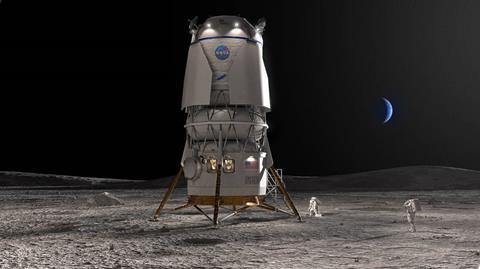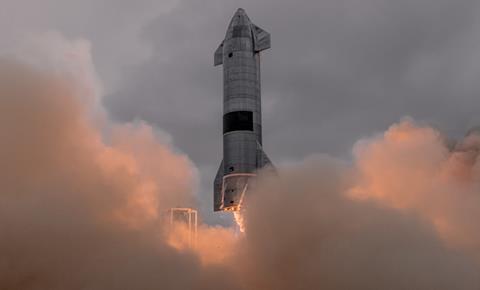The American space agency NASA has selected a second private company to land humans on the moon.

NASA on 19 May said it will contract with private spaceflight provider Blue Origin to develop a crewed landing craft for the agency’s Artemis programme, which seeks to return astronauts to the lunar surface more than 50 years after the final Apollo mission lifted off.
“Blue Origin will design, develop, test and verify its Blue Moon lander to meet NASA’s human-landing system requirements for recurring astronaut expeditions to the lunar surface, including docking with Gateway, a space station where crew transfer in lunar orbit,” NASA says.
The company created by Amazon founder Jeff Bezos now joins Elon Musk’s SpaceX in developing landing craft for the lunar effort.
The Blue Moon lander will be the landing component of NASA’s Space Launch System (SLS) heavy lift rocket being assembled by Apollo veteran Boeing. During humanity’s first foray to the moon, Boeing built nine of the Saturn V rockets that powered the Apollo missions.
The SLS, which stands taller than the Statue of Liberty, consists of a core rocket and two boosters that generate a combined 8.8 million pounds (39,100kN) of thrust – 13% more than used to lift the Rockwell International Space Shuttle into orbit, and 15% more than produced by Saturn Vs. According to NASA, SLS has capacity to carry more than 25,000kg (54,000lb) of cargo to the moon, compared to the 20,000kg capacity of the Space Shuttle, which could only reach low-Earth orbit.
Under the Artemis programme, NASA plans for astronauts to ride SLS to space inside Lockheed Martin’s Orion spaceflight capsule. From Earth orbit, Orion would carry the crew to the moon, and later back to Earth.
Blue Origin’s lander would ferry Artemis astronauts down to the lunar service and lift them back into moon orbit for the homeward journey aboard Orion. The still-under-construction Gateway orbital station is to serve as a transfer point between Orion and Blue Moon.
Colorado-based satellite provider Maxar Technologies will build Gateway’s power and propulsion system, while Northrop Grumman will construct the crew habitat section, which is to be capable of sustaining human life in the vacuum of space.
NASA is highly bullish on the new lunar programme’s prospects – and its collaboration with private industry on the effort.
“We are in a golden age of human spaceflight, which is made possible by NASA’s commercial and international partnerships,” says the agency’s administrator Bill Nelson. “We are making an investment in the infrastructure that will pave the way to land the first astronauts on Mars.”
Blue Origin is under contract for one uncrewed Blue Moon landing demonstration, followed by a crewed landing under the Artemis V mission scheduled for 2029. The contract is valued at $3.4 billion.
Unlike for the Apollo programme, NASA is not betting everything on one launch system for Artemis. The agency also contracted with reusable rocket pioneer SpaceX to develop a second, entirely separate platform for reaching the moon.

The SpaceX Starship heavy-launch system, which consists of a first-stage booster and a reusable flight vehicle and surface lander, is considered the largest rocket ever built.
At 120m (394ft) in height, the privately developed rocket system towers over even the Apollo-era Saturn V. The two-part launch system boasts a payload of 150,000kg (330,693lb) in its reusable configuration, and 250,000kg in expendable mode, according to SpaceX.
The company says it designed Starship with capability to reach the moon, but also Mars and deep space beyond.
The first launch of the fully-assembled Starship system on 20 April resulted in a catastrophic explosion roughly 4min after lift-off at an altitude around 95,000ft. The goal had been to reach roughly 770,000ft.
The outcome was not a surprise for the experimental system. Prior to the uncrewed test mission, SpaceX chief executive and founder Elon Musk estimated the probability of a successful launch to be around 50%.
“[We] learned a lot for the next test launch in a few months,” Musk tweeted after the fact.
SpaceX is under contract to provide one uncrewed and two crewed lunar-landing demonstrations with Starship before 2027. Those flights will occur under NASA’s Artemis III and IV missions.


























